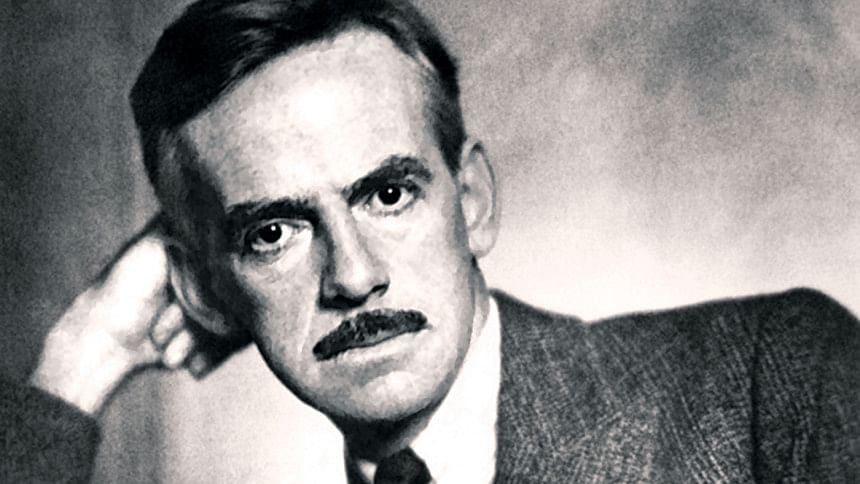Kissed by the dusk: Eugene O’Neill

It was in the seventh grade that I first learned about the Big Bang; the space-time singularity that held the universe in its womb, then BOOM! Before it was nothing, after it would be nothing; in-between there is something. The waves and particles of Starlight travel hundreds of thousands of years, millions of miles, until they lace into the eyeballs and drown. "We are, all of us, stardust, born of the same womb over thirteen billion years back," I wonder, "But where is the memory?"
Who was it that lived in your body fifteen years ago? Was it you, the same you that you now call "I"? Who would it be in another fifteen years? Are we but palimpsests of our memories? Eugene O'Neill painted our lives as microscopic specks in the colossus of space echoing in the deathless drumroll of time ticking to our own demise. He is ruthless in exposing the skull clad in skin and slug, wringing out the excess water from his family soaked in nostalgia.
"The past is the present, isn't it? It is the future, too. We all try to lie out of that but life won't let us." The malady of Mary, the portrayal of O'Neill's mother, Ella, in his autobiographical masterpiece Long Day's Journey into Night, is a malady of the knots – a veritable pastiche of the past spilling into the present and the future. Rheumatism blueprints Mary's mental state. Living in-between willed amnesia and forced anamnesis, Mary's faith in herself has been marred by the conscious decision not to become a nun or a concert pianist but to marry James Tyrone who adores her but almost always misunderstands Mary, and is, in turn, almost always misunderstood.
Throughout the play, Mary is pushed to paranoia by her family members' constant reminders of her Morphine addiction. They watch her watching them watch her. What is it about the gaze that sucks us in? When someone, an-other, looks at us, their lenses reflect the image of ourselves. And when we meet their gaze, watching ourselves in the eyes of an-other activates the Narcissus effect – the desire to drown in the eyes reflecting the image of our own. The equivalent for "ghost" in certain Indo-Aryan languages is "Bhoot," denoting that which has already been viewed. Dragging her wedding gown across memory lanes, Mary time-travels and freezes herself in the past as a convent girl, unmarried, haunting and haunted by the ghost of herself.
In fact, every family member in Journey has made chasing ghosts their forte. James Tyrone is magnetized by his dead mother who wore the crucifix of poverty like a garland around her neck. Fear is contagious; it makes nomads of the minds and steers us gently towards self-destruction. James buys more and more land to stop the mudslide under his feet. Unburdened by pride or shame, he wants to send his own son, Edmund, to the cheapest sanatorium on fatal risk from tuberculosis.
James had learned "the value of a dollar" at home, having been kicked out multiple times for falling back on the rent: his mother, two sisters, and himself at the age of ten – a lesson hard learned, never to unlearn. He, too, lives in pursuit of his ghost – what he might have been – a Shakespearean actor bathed in glory, forever "alive in his great poetry." The terror of death in destitution had nailed the coffin of his dreams. "We are such stuff as dreams are made on," James quotes from The Tempest, "And our little life is rounded with a sleep."
"We are such stuff as manure is made of," Edmund counters with typical morbidness and cynicism, rubbed off on by Jamie, his elder brother and role model. Jamie is a walking contradiction. He looks like his father but doesn't; almost handsome but isn't; kissed by the dusk, yet dusky. He had measles at the age of seven, spread it to his infant brother, Eugene, who had subsequently succumbed to it. Since then, Mary had sentenced Jamie to life imprisoned by bitterness, skepticism, lust and drunkenness. Fratricide! Trailing the ghost of his brother, Jamie nosedives into the mist.
Edmund, the youngest, fancies being cloaked by the fog; his name being the only theatrical adjustment. The fact that the author, Eugene, trades his name with his elder brother who died in infancy betrays the centrality of silence and absence. In life, Edmund dies to give Eugene life; in the play, Eugene dies and Edmund is conceived to replace the child deceased. Taking the birth of Edmund as the event that hooked Mary to the needle to boot, we realize why Edmund calls himself "a ghost within a ghost."
In essence, O'Neill's oeuvre explores shadows of death in life itself. Hades was his mentor, Poseidon his priest. The sea is the only place he wanted to be, for the sea is everything the world is not. Everything dissolves in the sea; dissolves, then dissipates, finally disappears. The sea is the watery grave of memories. "We must suffer, suffer into truth," Aeschylus said. For O'Neill's project of willed amnesia untying the knots of past sufferings, theater was the perfect medium.
Theater is the edge that impales, holds a mirror before the audience and bars all exit. The spectators – bedimmed, spectral – are central to meaning-making, for the origin of both "theory" and "theater" is theoria – "to watch." The audience watch the characters watching the audience – forming centrifugal patterns of concentric circles ever narrowing until they converge at the nuclear core and implode, drowning not just the eyes but the minds from the gallery into the stage, breaking time and space, breaking barriers.
Writing himself enabled O'Neill to answer that age-old existential question for the theater: "Who am I?" The answer, "No-body," broadening the horizon to transcend the material with the natural. He stammers and limps across the stage of life. But once he starts unfolding the confines of the "I," he belongs "without past or future, within peace and unity and a wild joy, within something greater than my own life, or the life of Man, to Life itself," Edmund finds the sublime in the simplicity of "green seaweed anchored to a rock, swaying in the tide,". From a creature, he becomes the creator.
Gazing at the "dim starred sky" lacing into his eyes, Edmund is forged into an epiphany – his "I" diminishes in the eyes of the universe – the secret he sees and becomes cannot be expressed, only experienced; being riverrun, the epiphany sails at the interstices of being and nothingness. It is what certain Tantric discourses term "awareness" and "becoming," undoing the existential angst arising from the identification with and centrality of the "I." Edmund must always be "a little in love with death" because he was never born, and therefore, can never die. The "I" from fifteen years ago is not the "I" of today or the "I" twenty years from now; skating the glaciers of Evolution entails no teleology or finished product. Life is about absorbing the world entire in all its minutiae and memories spanning thirteen billion years; to be kissed by the dusk and dissolve, spinning the wheels of suffering till the mist melts amid the falls, weaving truth and the tale of immortality.
S M Mahfuzur Rahman is a Lecturer in the Department of English and Humanities at University of Liberal Arts Bangladesh (ULAB).

 For all latest news, follow The Daily Star's Google News channel.
For all latest news, follow The Daily Star's Google News channel. 



Comments